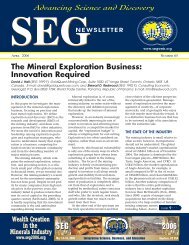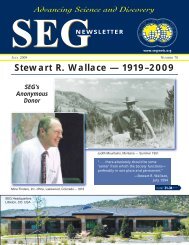SEG 45 Final_qx4 - Society of Economic Geologists
SEG 45 Final_qx4 - Society of Economic Geologists
SEG 45 Final_qx4 - Society of Economic Geologists
Create successful ePaper yourself
Turn your PDF publications into a flip-book with our unique Google optimized e-Paper software.
OCTOBER 2005 • No 63 <strong>SEG</strong> NEWSLETTER 21<br />
AFRICA<br />
Regional Correspondent:<br />
Judith Kinnaird (<strong>SEG</strong> 2002)<br />
<strong>SEG</strong> Regional Vice President Africa<br />
School <strong>of</strong> Geosciences<br />
University <strong>of</strong> the Witwatersrand, South Africa<br />
Tel: +27 11 7176583<br />
Fax +27 11 7176579<br />
Email: kinnairdj@geosciences.wits.ac.za<br />
With contributions from<br />
Dr. Stephen Frindt<br />
Geological Survey, Namibia<br />
COTE D’IVOIRE<br />
Cluff Gold bought the exploration data<br />
covering the Mt. Yaoure licence. This<br />
includes drill assay results from drilling<br />
completed around the Angovia mine,<br />
from the previous licence-holder<br />
Comincor. Internal company reports by<br />
Comincor indicate a resource <strong>of</strong> 90,000<br />
t at a grade <strong>of</strong> 3.7 g/t, based on drilling<br />
completed in 2002.<br />
GHANA<br />
Golden Star Resources announced that<br />
the plant at Wassa gold mine is now<br />
operating at its design capacity <strong>of</strong><br />
10,000 tpd. The standby powerhouse<br />
was recently upgraded to supply sufficient<br />
power while connections to the<br />
national grid are being completed.<br />
MADAGASCAR<br />
Rio Tinto announced the approval <strong>of</strong> a<br />
US$585M mineral sands operation and<br />
port. First production in the Fort<br />
Dauphin region is expected in late<br />
2008 and initial capacity will be<br />
750,000 tpa <strong>of</strong> ilmenite. The development<br />
is the largest project in<br />
Madagascar’s history and will be the<br />
catalyst for broader economic development<br />
in the region. With a grade <strong>of</strong><br />
60% titanium dioxide, the Madagascar<br />
orebody is the largest known undeveloped<br />
high-grade mine, according to Rio<br />
Tinto.<br />
MALI<br />
Randgold Resources, the Malian gold<br />
producer, approved a US$100M underground<br />
project at its open-cast Loulo<br />
mine.<br />
EXPLORATION REVIEWS<br />
NAMIBIA<br />
Navachab gold mine (AngoGold<br />
Ashanti Ltd) situated in central-western<br />
Namibia, was developed in the late<br />
1980s and was interpreted as a skarn<br />
deposit with a life <strong>of</strong> mine until 2003.<br />
However, with the discovery <strong>of</strong> the significance<br />
<strong>of</strong> associated sheeted auriferous<br />
quartz veins and the reinterpretation<br />
<strong>of</strong> the deposit as a mesothermal<br />
gold deposit, exploration located additional<br />
resources both in the hanging<br />
wall and the footwall. This increased<br />
life <strong>of</strong> mine to 2013 and, pending on<br />
the economic conditions, there is a<br />
chance <strong>of</strong> extending it even further.<br />
Namibia Stone Processing (NSP)<br />
plant, situated in the town <strong>of</strong> Omaruru,<br />
is one <strong>of</strong> the biggest dimension stone<br />
processing facilities in southern Africa.<br />
NSP is a black economic empowerment<br />
initiative, which was inaugurated by<br />
the Namibian President Hifikepunye<br />
Pohamba on July 20, 2005. The plant,<br />
built at a cost <strong>of</strong> N$50M, will process<br />
granite and marble tiles derived from<br />
local quarries as well as darker varieties<br />
<strong>of</strong> dimensions stone from Angola,<br />
Zimbabwe, and South Africa. The plant<br />
will employ between 70 and 100 people,<br />
with staff to be trained by Italian<br />
experts in stone processing, especially<br />
for marble tiles. The plant houses 2<br />
granite gangue saws, 2 granite block<br />
cutters, 2 marble block cutters and 1<br />
marble gangue saw. At full capacity the<br />
plant will produce some 3,000 m 2 <strong>of</strong><br />
polished tiles per machine per month.<br />
The market is currently aimed at local<br />
and SADC countries, in future the company<br />
plans to expand their market to<br />
include European, American and<br />
Middle and Far Eastern countries.<br />
Vancouver-based junior, Helio<br />
Resource Corp, through its 100%<br />
owned Namibian subsidiary BAFEX<br />
Exploration, is currently exploring for<br />
copper and gold in northern Namibia.<br />
Helio has just completed a first-pass RC<br />
and diamond drilling program on the<br />
Otjitombo project, where significant<br />
intersections including 39.82 m @<br />
1.03% Cu and 0.12 g/t Au, 32 m @<br />
0.97% Cu & 0.11 g/t Au and 22 m @<br />
1.06% Cu, and 0.26 g/t Au have been<br />
reported, with numerous assays still<br />
pending. Elsewhere Helio has entered<br />
into a significant option agreement<br />
with Teck Cominco whereby Teck can<br />
earn up to a 75% interest on delivery <strong>of</strong><br />
a feasibility study on the Vredelus gold<br />
prospect. Helio is also active exploring a<br />
number <strong>of</strong> IOCG prospects in the north<br />
<strong>of</strong> the country, two <strong>of</strong> these are in conjunction<br />
with fellow Vancouver Juniors<br />
Boulder Mining Corp and Yale<br />
Resources. Helio is also active in diamond<br />
exploration in Botswana, where<br />
it has optioned the Lokgwabe prospect<br />
to Indicator Minerals. Historic data at<br />
Lokgwabe indicates the presence <strong>of</strong> G10<br />
indicator garnets.<br />
Rössing, the large open-pit uranium<br />
mine producer, which is situated 65 km<br />
inland from the coastal town <strong>of</strong><br />
Swakopmund, started operations in<br />
1976. Rössing is one <strong>of</strong> the largest<br />
open-pit uranium mines in the world<br />
and with solid reserves will continue to<br />
serve the world nuclear energy industry<br />
throughout the world, especially in<br />
Central Europe, North America, and<br />
Southeast Asia. The mine currently<br />
produces about 7.7% <strong>of</strong> the world’s<br />
uranium. In 2004, the life-<strong>of</strong>-mine<br />
plan forecast closure in 2009. However,<br />
they aim to develop and expand their<br />
capacity to deliver value to shareholders<br />
and local stakeholders for the long<br />
term and they are working on plans to<br />
justify extending the mine life to 2017.<br />
On the operations side, production will<br />
be increased to 3,800 t <strong>of</strong> uranium<br />
oxide for 2005 to counteract the negative<br />
economic impacts <strong>of</strong> the “weak”<br />
US dollar, in which Rössing’s uranium<br />
is sold. The work <strong>of</strong> the Rössing<br />
Foundation in the mine’s neighboring<br />
town, Arandis, was expanded as the<br />
Rössing Foundation strives to ensure an<br />
economically independent and selfsustaining<br />
town.<br />
Avdale Namibia (Pty) Ltd is a<br />
wholly owned subsidiary <strong>of</strong> African<br />
Rainbow Minerals (ARM). Thirteen<br />
EPL’s were awarded during 1997, covering<br />
1,060,000 hectares over an area<br />
from Tsumeb in the north to<br />
Otjiwarongo in the south, Outjo in the<br />
west to Grootfontein in the east. This<br />
has now been reduced to four EPL’s covering<br />
308,000 hectares. Copper, zinc,<br />
and gold were initially the main exploration<br />
commodities in the northern<br />
Carbonate platform, northern rift-margin<br />
and Northern Zone <strong>of</strong> the Pan-<br />
African Damara orogen. The terrain is<br />
extensively covered<br />
by a thin calcrete<br />
to page 22 ...<br />
EXPLORATION REVIEWS






